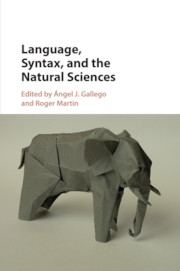Book contents
- Language, Syntax, and the Natural Sciences
- Language, Syntax, and the Natural Sciences
- Copyright page
- Dedication
- Contents
- Contributors
- Acknowledgments
- Introduction
- Part I The Computational Component
- 1 Deriving Multiple “Object” Constructions
- 2 Verbal Complex Formation and Overt Subjects in Infinitivals in Spanish
- 3 Two Families of Questions
- 4 Context-Sensitive Aspects of Constituent Negation
- 5 Phasehood and Romance Adverbial Because-Clauses
- 6 No-Choice Parameters, Phi-Features, and the Structure of DP
- Part II Interfaces
- Part III Linguistics and Other Sciences
- Index
- References
2 - Verbal Complex Formation and Overt Subjects in Infinitivals in Spanish
from Part I - The Computational Component
Published online by Cambridge University Press: 02 October 2018
- Language, Syntax, and the Natural Sciences
- Language, Syntax, and the Natural Sciences
- Copyright page
- Dedication
- Contents
- Contributors
- Acknowledgments
- Introduction
- Part I The Computational Component
- 1 Deriving Multiple “Object” Constructions
- 2 Verbal Complex Formation and Overt Subjects in Infinitivals in Spanish
- 3 Two Families of Questions
- 4 Context-Sensitive Aspects of Constituent Negation
- 5 Phasehood and Romance Adverbial Because-Clauses
- 6 No-Choice Parameters, Phi-Features, and the Structure of DP
- Part II Interfaces
- Part III Linguistics and Other Sciences
- Index
- References
Summary
- Type
- Chapter
- Information
- Language, Syntax, and the Natural Sciences , pp. 34 - 57Publisher: Cambridge University PressPrint publication year: 2018
References
- 2
- Cited by



